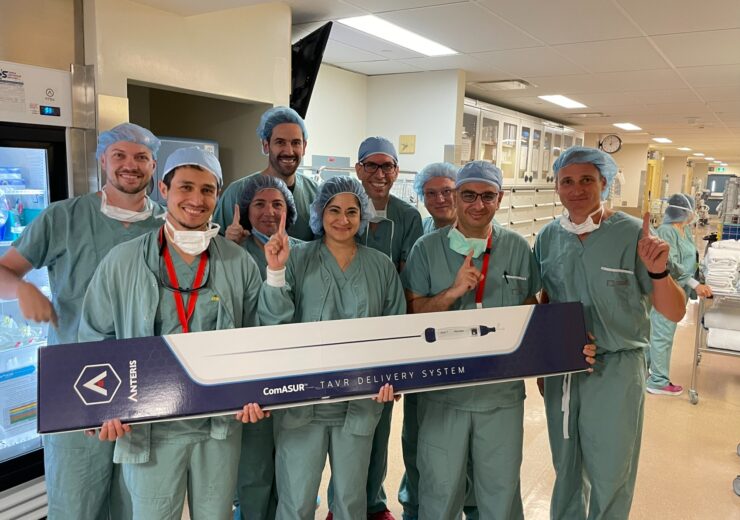A ViV procedure is required for patients with a life-threatening situation wherein their current bioprosthetic aortic valve is failing due to calcification or structural deterioration, and a new heart valve must be implanted inside the failing valve

Dr Anita Asgar (centre) Co-Director of the Structural Heart Program at the Institut de Cardiologie de Montreal, Anteris Technologies Chief Medical Officer, Dr Chris Meduri (far right), with the Anteris Technologies clinical team with the DurAVR THV investigational device (Credit: Business Wire)
Anteris Technologies, a structural heart company developing DurAVR THV, a new class of biomimetic heart valve and the world’s only balloon-expandable, single-piece transcatheter aortic valve shaped to mimic the performance of a native human aortic valve, announces that the DurAVR THV was used for the first time in a valve-in-valve (ViV) procedure as part of Health Canada’s Special Access Program (SAP).
A ViV procedure is required for patients with a life-threatening situation wherein their current bioprosthetic aortic valve is failing due to calcification or structural deterioration, and a new heart valve must be implanted inside the failing valve. These patients are at high risk for another surgery and require a minimally invasive treatment option. Canada’s SAP exists so that life-saving technology not currently available for commercial use in Canada can be provided when no other commercially available alternatives are suitable.
Dr. Anita Asgar, Co-Director of the Structural Heart Program at the Institut de Cardiologie de Montreal (Montreal, Canada), made the request to Health Canada to use the DurAVR THV in a patient with a failing valve that needed optimal hemodynamic results as well as a short frame height as they were very high risk of poor hemodynamic result with a conventional ViV procedure. Dr. Asgar performed the procedure on an 84-year-old male and implanted a DurAVR THV inside the failed surgical aortic valve replacement (SAVR).
The procedure was successful. The hemodynamic performance of the valve was outstanding in such a complex patient. The patient had an 88% reduction in mean gradient which brought the patient back to a near-normal physiologic state, with a final gradient of only 6mmHg after deploying the valve. These results mirror what DurAVR THV has seen in its extensive ViV bench-top studies.
Dr. Asgar commented:
“The DurAVR THV provided a life-saving solution for a patient requiring a new valve to be implanted without compromising hemodynamic performance or future coronary access. These hemodynamic results are not seen with currently available products, which is important as there is a large need for a valve that can offer optimal hemodynamic performance in the valve-in-valve setting, particularly with a shorter frame height. Additionally, despite this being an incredibly complex case, using Anteris’ ComASUR delivery system and deploying the valve was remarkably easy. The unique design of DurAVR, including the low frame height and the single-piece design, makes the valve well-suited to address the needs of valve-in-valve patients.”
Source: Company Press Release
